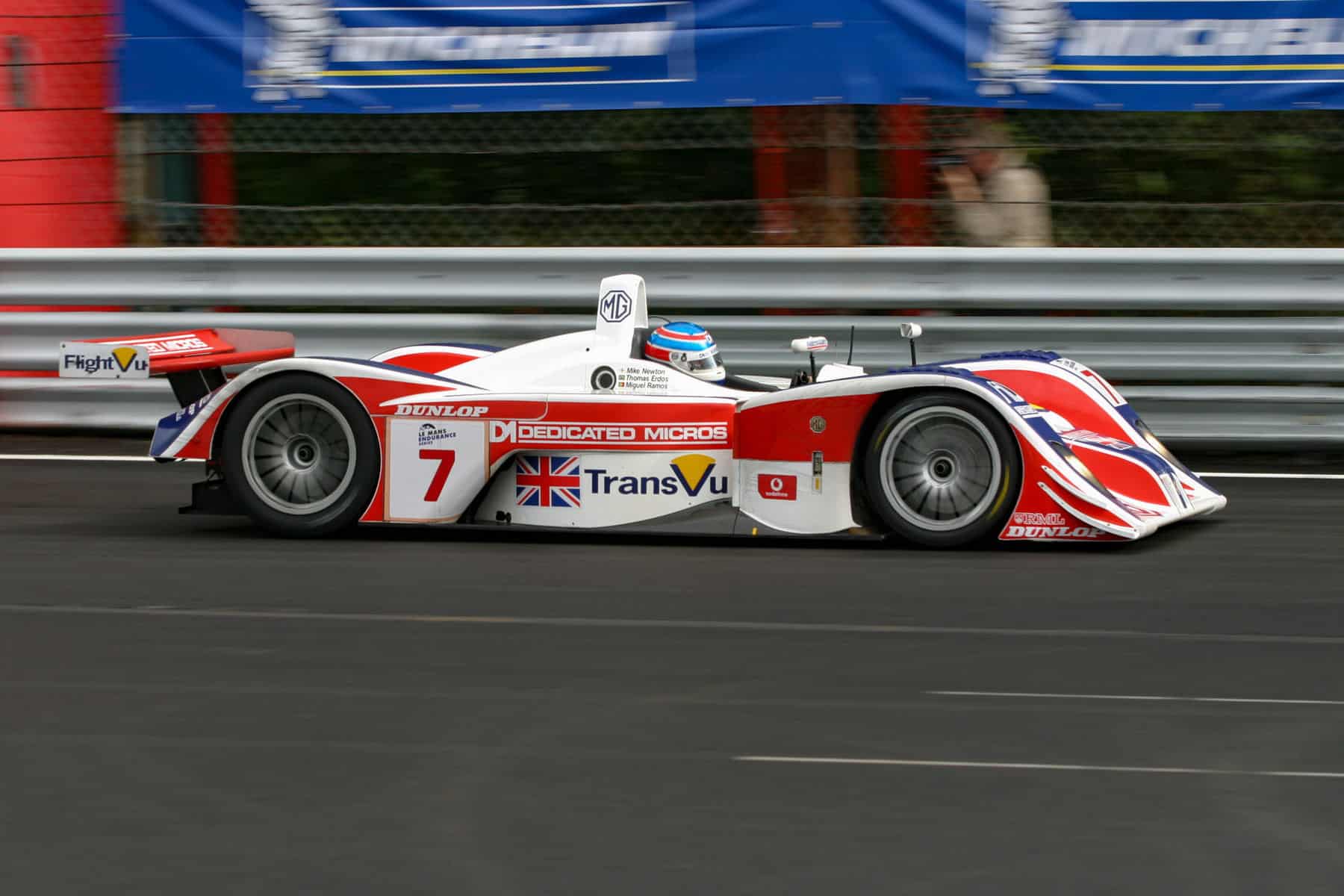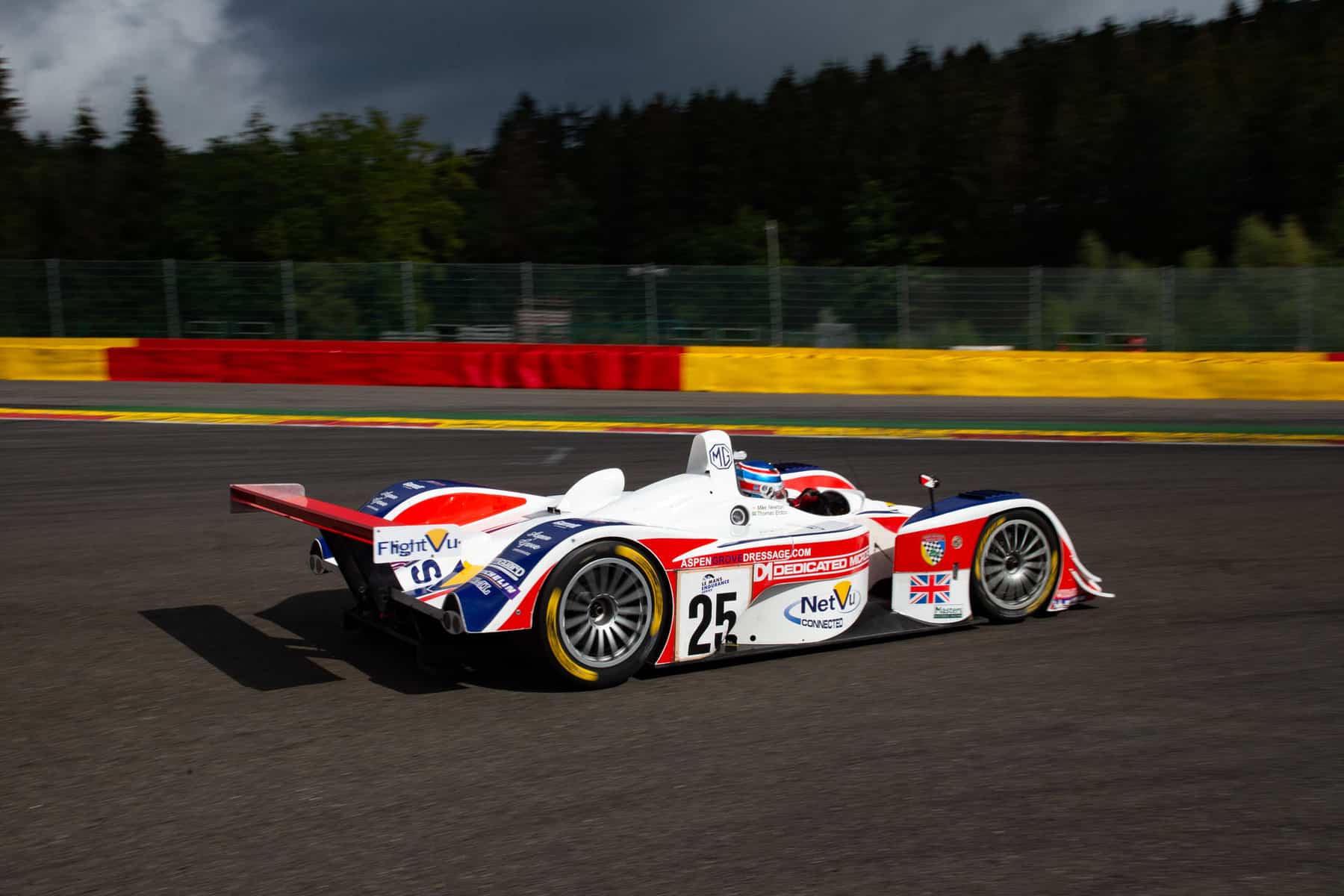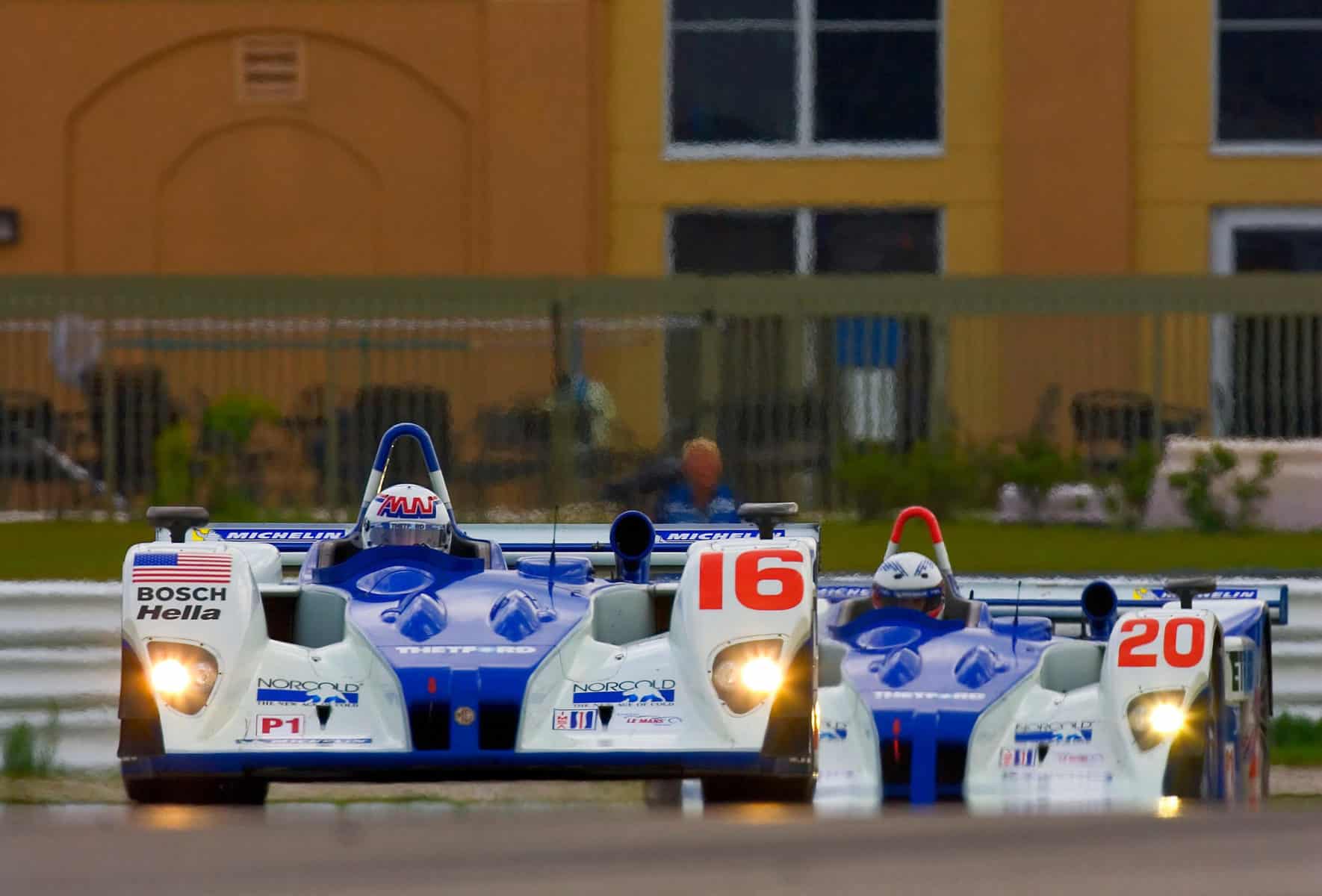MG Lola EX257
When David and Goliath met on the track
BY: WOUTER MELISSEN
Ahead of the 2000 season, the Automobile Club de l’Ouest created the sports-car racing equivalent of the match-up between David and Goliath.
One of the major tasks of motorsport’s sanctioning bodies is to create a level playing field. A tried and true method was to set an engine displacement limit and determine a minimum weight. This generally resulted in cars of a similar size going head-to-head. Organizers of the 24 Hours of Le Mans, the ACO, instead created two distinct prototype classes that would both be capable of vying for outright victories. The two categories replaced the single LMP or Le Mans Prototype class, which sanctioned the open sports prototypes that raced at Le Mans in 1999.
Goliath was represented by the LMP900 class, which carried over the same parameters as used for the LMP cars in 1999. These included a minimum weight of 900 kg, hence the name, and different displacement limits for naturally aspirated and turbocharged engines. All new was the LMP675 class, which obviously had a minimum weight of 675 kg. As for engines, turbocharged engines could displace no more than two liters, while naturally aspirated engines had the maximum set at 3.4 liters.
Looking to appeal to as many engine manufacturers as possible, the engine regulations included an intake restrictor that differed in size in relationship to the engine displacement. This allowed engines to be competitive even if they did not sit right at the displacement limit. Audi, for example, won the 24 Hours of Le Mans in 2000 with the R8 that was powered by a 3.6-liter V8 even though the LMP900 regulations allowed for a displacement of up to four liters for a turbocharged engine.
The LMP675 cars that lined up for the 24 Hours in 2000 were still based on machinery that had competed in the LMP2 and SR2 categories. While now eligible for the LMP675 class, they had been built to compete in what were junior categories with privateer teams and struggled in their newfound headlining role as David. Things were different at the next edition, as MG Rover had taken up the gauntlet or more accurately the sling. A small displacement, lightweight LMP675 sports racer was a perfect fit for a company like MG from a marketing perspective.

To develop what would be known as the MG EX257, the British manufacturer called in the help of sports-car specialist Lola. It was a logical step, as two of MG’s executives also served on the board of Lola. For the 2000 season, Lola had produced both a full-blown LMP900 car (B2K/10) and also the B2K/40 for the LMP675 class. The latter represented a bit of a compromise, as it could be run both as a LMP675 in the ACO sanctioned events but also as an SR2 in North American Grand Am events. They were certainly never capable of chasing down the LMP900 cars.
Tasked with the design of what was known internally as the Lola B01/60 were Frank Dernie and Julian Sole. To make up for the power deficit compared with the LMP900 cars, Dernie and Sole were careful to make the car as aerodynamically efficient as possible. It featured very slim front fenders, which were effectively separate from the rest of the bodywork. By routing the airflow around the fenders, out the sides of the car, the drag was considerably reduced. The rear wing was behind the bodywork and relatively low, which was also to keep the drag down.
Underneath the slippery carbon-fiber composite body panels, the EX257 boasted a carbon-fiber and aluminum honeycomb monocoque. Suspension was by double wishbones on all four corners. The springs and dampers were mounted in-board and were actuated through push-rods. Specialists Advanced Engine Research was tasked with the development of a four-cylinder, turbocharged engine. It was dubbed the MG XP-20 and produced around 500 hp with the mandatory restrictor fitted. The ‘four’ was mated to a six-speed sequential gearbox that was very light, thanks to the use of a magnesium casing.
Painted in a striking grey with bright-green livery, the MG Lola EX257 debuted at the official Le Mans test in May 2001. The effort was run by the highly experienced Chamberlain Engineering team. The two cars were manned by an all-British, all-professional driver line-up. The cars tipped the scales at 690 kg, which was just over the minimum weight. Combined with the engine’s output of 500 hp, this gave the EX257 a favorable power-to-weight ratio over the dominant Audi R8 LMP900 car.
The nature of the Le Mans track with its long straights sadly favored raw power more than a superior power-to-weight ratio. For the race in June, the two MGs lined up fourteenth and seventeenth on the grid. This was well ahead of the other LMP675 cars, but the fastest EX257 was still nearly eight seconds off the pole. In the race, the MGs proved fast but also fragile. The Achilles heel was the high-strung engine with the first car out after just thirty laps due to an exhaust failure. The second car lasted a few hours longer but was then out of the race due to an oil leak.
The MG team sat out the rest of the season and focused on refining the cars for another Le Mans attempt in 2002. For that season, the car was also made available to customers. Two examples were acquired to race in the American Le Mans Series, by Intersport Racing and KnightHawk Racing. The two cars debuted at the Sebring 12 Hours where the KnightHawk car proved blisteringly fast in qualifying. It was, however, the Intersport car that achieved the first success for the EX257 by finishing seventh overall and first in the LMP675 class. Later in the year, the two cars scored four more class wins in the ALMS.
For the 24 Hours of Le Mans, MG Sport & Racing fielded two cars again. The KnightHawk team also brought over their EX257 to compete in the French classic. The work over the winter had clearly paid off, as the fastest of the MGs was a full seven seconds faster than it had been during the previous year. That was good for sixth on the grid. While the cars were faster, reliability was still an issue and none of the three EX257s reached the finish. The Le Mans effort proved too expensive for the ailing MG Rover company and the program was canceled after just two outings.
It was certainly not the end of the line for the EX257, as it would continue to be raced by additional privateers Dyson Racing in the ALMS and by RML in Europe. Dyson Racing had previously run aging Riley & Scotts in the LMP900 class, which were no longer a match for the Audis. Driver Chris Dyson explains the choice for the EX257: “We realized that the only way to take on the Audi R8 and to win in the ALMS was an alternative approach. And the LMP675 equivalency formula seemed to present the best opportunity. Lola had introduced the MG-Lola at Le Mans that year and had shown some pretty massive potential despite a short development timeframe.”
Originally developed for Michelin tires, it took Dyson Racing some time to get its EX257s dialed in: “We had a very close, over two-decade relationship with Goodyear and Goodyear agreed to support us. The early races were a steep learning curve and we realized some of the deficiencies in the package early and moved quickly to adapt the suspension to the Goodyear’s characteristics. At Road Atlanta, which was just a few races into the program, we qualified third and led laps, and this gave us a boost heading into 2003.”
Dyson recounts the hugely successful 2003 season: “Over the winter we were able to acquire the second car from KnightHawk Racing, and this meant for 2003 we began the season with two cars with the dual objective of mounting a championship effort and winning races overall. The car proved fast at many tracks that year and we managed to win the championship with my No. 20 car, which we still own. We took a memorable victory in Sonoma where the Goodyear tires were simply sensational.” The Dyson Racing EX257s scored six class wins in nine races, while Intersport won the other three.
The only EX257 that was raced in Europe was acquired by gentleman racer Mike Newton and fielded by RML. For him, the car also provided a steep learning curve but for a different reason. Newton was still relatively new to racing in general: “It was a very quick transition from endurance racing in both BTTC and Australian Touring cars, to a season in British GT in a GT2 Porsche in 2002, and then the next season into a GT1 Saleen S7R. This was certainly a lot faster than my planned progression, however I have always felt that if an opportunity arises, then you should seize the moment, rather than look back later and regret letting it pass by.”
The RML EX257 debuted at the Le Mans 1000 km late in 2003 and Newton grew quickly accustomed to it: “As the majority of my racing had been in single seaters, primarily various iterations of Formula Ford 1600s, I found the lack of precision with the GT1 car quite difficult to get used to. The Saleen S7R was an excellent car, and it would have been so much more difficult with a lesser chassis, however it doesn’t matter how good the design is, finding the apex to inch perfect position with a car weighing 1,200 kg, arriving at 150 km/h is never going to be easy. From the first race at the end of 2003 at the Le Mans Bugatti circuit, I really enjoyed the precision of the LMP675 chassis. The MG Lola was one of the first fully carbon fiber LMP cars, and that was reflected in the precision of the handling.”
Dyson is also still full of praise about the EX257: “The car was a joy to drive and its light weight made it excel on the brakes. The aerodynamic characteristics made it outperform the Audis on faster circuits, and generally it had surprisingly low drag. AER gave us great power for the car’s weight and the low-drag design allowed us to perform really well on tracks like Road America where one would have initially thought a lower-powered car would be at a disadvantage. Fans loved the cars, too. They were gorgeous machines, and the distinctive chirps of the waste-gates were crowd-pleasing.”
For Newton, the brakes of the EX257 also stood out: “The other truly amazing thing was the stopping power, with the new levels of downforce and carbon brakes. I had already been utterly amazed by the braking performance of the Saleen at Le Mans, which was the first time I had experienced carbon brakes. It seemed ridiculous just how crazily late you break at the end of the Mulsanne straight. However, the brakes on the EX257 were a whole new level again. Even though it was wet all the way through the meeting, the combination of brakes and downforce made it feel as if you were hanging out of the seat in the seat belts, despite the wet conditions.”
Ahead of the 2004 season, the prototype class structure was altered again. The existing LMP675 and LMP900 cars were now all slotted in the new LMP1 class. The prototype ranks also included a LMP2 class that was intended for privateers and gentleman racers. Dyson Racing was chasing outright victories anyway, but for the RML effort, the rule changes did make a difference: “In 2004 we were forced to run with the LMP900 in the LMES, which made class or outright podiums very difficult.”
After the championship-winning effort in 2003, Dyson Racing had high hopes for 2004. It proved to be more difficult than expected: “It was a more mixed season plagued by some reliability as we began to explore the upper limits of the car’s performance. Still, we had some great races where the car’s fundamental speed shone and the win at Mosport was a thrilling one.” Dyson Racing ended the year second in the LMP1 standings behind the ADT Champion Racing Audi team, which had won seven of the nine ALMS rounds.
Dyson explains that the best was yet to come despite the EX257 going into its fifth season of racing: “In 2005 we switched over to using Michelin tires and had near-perfect reliability with the No. 20 car, with both cars competing strongly at all the venues. We took two well-earned wins at Mid-Ohio and at Mosport and should have won at Portland but for a fuel miscalculation and a gearbox glitch on the 16 and 20 cars, respectively.”
“The battles between us and the dominant Audis, which larger, major manufacturers had tried and failed to beat, were simply epic.” Dyson recalls: “It was a wonderful era, too, because development was still allowed and the competition between tire brands only added to the excitement and variability. If you ask any of the drivers of the time on either the Dyson or Audi side, they would all say that we enjoyed great, close racing and that the races were very memorable.”
Back in Europe, Newton and RML had switched to the LMP2 class for 2005 with a new Lola-built evolution that was badged the MG Lola EX264. Newton remembers this car fondly: “The EX264 was an amazing car, and we were able to take our first class win at Le Mans, although missed out on the series by just one point. This was to repeat in 2006, although at Le Mans in 2005 it had been more a race of survival – who could drag one of the new LMP2s to the end of the race. In 2006 it was a completely different matter – bringing the MG Lola home in eighth to the class win, nearly three hours ahead of the previous year’s finish twentieth overall. We finally conquered the LMES series in 2007, taking the LMP2 Series class win.”
Newton did not retain all of the cars he had raced, but did hold on to the EX257. With the arrival of the Masters Endurance Legends and the Enduring Racing Legends, the car changed from an old racing car to a historic racing car. Restored to full running order, Newton’s EX257 has been raced at several historic events since 2018: “I was back in the EX257 for the first time since 2004. By the time I had last raced in LMP2 in 2011, the minimum weight had risen to 925 kg – so it was a great joy to be back in the EX257 with a typical all up weight of around 700 kg, and so much nimbler again. This combined with the improvements in tire technology in between has made it a true pleasure to drive again.”
For Dyson, running the EX257 for three full seasons was one of the highlights of his racing career: “From a personal standpoint, I have fond recollections from the time and the David versus Goliath element made the successes we had even more special in retrospect.”
The LMP900 / LMP675 era was short-lived but thanks to the MG factory effort and the subsequent privateer efforts, it provided the David versus Goliath match up the rules had promised. Today, the basis for the regulations is a balance of performance, which effectively means that the faster cars are slowed down to create a level playing field. This will make a repeat of these fabulous battles between two very different cars highly unlikely.










